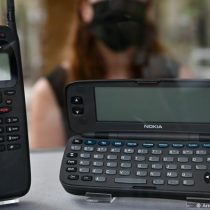
25 years ago, Nokia promised “the office in the pocket” by launching a mobile phone that can be considered the precursor of today’s ‘smartphones’. It’s better that it’s a bulky vest pocket: the Nokia 9000 Communicator model was almost four centimeters thick and weighed just under 400 grams. But, like a mini laptop, it could be opened to display a keyboard and a 4.5-inch black-and-white screen (an 11.5 cm diagonal).
The Nokia 9000 Comunicator was presented at the CeBIT 1996 computer show in Hannover, Germany, and was launched on August 15 of that year. The device marked the idea of what a smartphone should look like for a decade: with buttons. Many buttons. They were small computers for people who were very much on the move.
The Nokia Communicator 9000.
Blackberry phones based on the same idea
After the Communicator, Blackberry phones with their keyboards took the idea to perfection, until Apple’s iPhone, with its multi-touch screen, torpedoed this concept in 2007 and laid the foundations for today’s smartphones. Which, by the way, can function as offices in the vest pocket, as seen especially in the Corona pandemic. However it was also Nokia who released the first touchscreen phone: the Nokia 7710.
It was not as successful as expected. The Finnish manufacturer must have thought that the public did not want touchscreen phones. Even the Nokia 7700, a previous model announced at the Mobile World Congress in 2003, which was then in Cannes and not in Barcelona, did not go on sale.
The Nokia 7710 in a store in Copenhagen: it cost more than four thousand crowns in 2007, about 550 euros.
In the 1990s you could only dream of the capabilities of today’s smartphones, such as microsoft’s visionary short film “Information at your fingertips” from 1994, which showed pocket devices with large screens connected to the internet.
In the video that Bill Gates presented in a speech at the now defunct Comdex computer fair in Las Vegas, the ‘smartphone’ was also used to pay for a contactless and cashless coffee.
At the same time, it was a time of emergence in which many tried to make a reality, with the available technology, at least some innovations in mobile technology. The bolder the visionaries, the louder some of the failures were.
Blackberry’s PDA (‘personal digital assistant’) at a presentation at the IFA trade show in Berlin in 2005.
Failures not only at Apple
The Apple company, adrift without its founder Steve Jobs, had a failure with its Newton. The particularity of the device was that it had to recognize handwriting with a stylus and a large screen, but the software failed to do just that.
The start-up General Magic tried for years to launch a touchscreen device that conceptually anticipated many of the functions of later smartphones, but in the end it was too ambitious for the technical possibilities of the moment.
Small takeout office
The strong point of Nokia’s approach to the Communicator was its simplicity. The device didn’t promise any revolutionary innovation, but it really offered the ability to perform some office tasks on the go. It was possible to send and receive faxes and e-mails. The device also offered access to an address book and an address book. The price was 2,700 frames without a SIM card (that is, about 1,380 euros -taking into account inflation, it would be much more now-).
Folded, the 9000 Communicator looked like a conventional, simple mobile phone, with dial keys and a small screen, but a little bulkier. The interior screen had a resolution of 640 by 200 pixels. This seems like a joke by today’s standards, but back then, 640 by 480 pixels were the standard even for large computer monitors.
The Nokia Communicator with its auto adapter.
Today, collector’s items
The first Comunicator had no GPS positioning, no camera, no headphone jack, that is, many of the things that today make up a ‘smartphone’. However, the device was successful enough for Nokia to launch other models over the years, which were technically updated. A last attempt to bring the concept into the era of modern smartphones did it.s Finns in 2011 with the Nokia E7, in which the screen could slide up to show the keyboard underneath.
Those who still have a Nokia Communicator 9000 lost in drawers should not throw it away for hazardous waste recycling at the next cleanup. On eBay and other platforms, the first ‘smartphones’ continue to have demand and reach sales prices above 500 euros.





